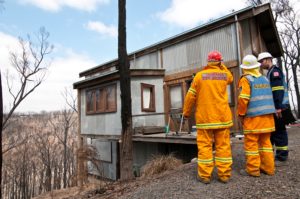Disaster resilience and extremes

CSIRO was a participating agency in the Bushfire Cooperative Research Centre, which looked at the key issues in the February 2009 bushfires.
Extreme weather events are rare and often damaging. They can include severe temperatures, torrential rainfall, large hail, strong wind gusts, fire, tropical cyclones, and high sea levels.
In Australia the impact and cost of recent extreme events has been significant in the short term to the economy, society and the environment:
- The Victorian bushfires in early February 2009 killed 173 people and more than one million animals. They destroyed more than 2000 homes, burnt about 430 000 hectares, and cost about A$4.4 billion (Victorian Bushfires Royal Commission, 2010).
- The south-east Australian heat wave in late January 2009 resulted in 374 more deaths in Victoria than what would be expected (Victorian Department of Human Services, 2009).
- The hailstorm in Sydney on 14 April 1999 resulted in insurance claims totalling A$3.3 billion (inflation adjusted: Insurance Council of Australia, 2010).
- The floods in eastern Australia in early 2011 cost about A$12 billion in lost revenue (1.7 per cent of GDP), mainly through lower coal and agricultural production (Swan, 2011). However, there is debate about how the cost should be calculated (Kazakevitch, 2011).
In the absence of intervention, we know the frequency of many of these events and their impacts will continue to increase over coming decades, due to population increase, property development and climate change. This will impact the bottom line of government budgets at all levels. It will also affect loss of life – for example, once mean temperatures increase more than 2°C, the effect of heatwaves on years of life lost rises rapidly.
Yet we know that preparing for extreme events better, through planning, engineering and awareness, can greatly reduce the social and economic costs of these events. For example, cyclone building codes in northern Australia are very effective at reducing damage from high intensity wind events. Thus Australia can prepare better for extreme events, and recover from them more quickly.
CSIRO is working to help halve the projected death rate due to all types of extreme events and to halve their projected economic costs by 2050.
Find out more about CSIRO’s current research into extreme events.
